When people ask me why I went to Nicaragua, I tell them the truth: I Googled “cheapest country in Central America.” I had a US visit visa, a tight budget, and zero desire to spend $9 on an açai bowl in Costa Rica. Nicaragua popped up with $1 mangoes, active volcanoes, and surprisingly few people talking about it — so I booked a flight with no expectations.
And that might be why I loved it so much.
No one tells you that Nicaragua has beaches you can have to yourself. Or that the volcanoes are steep, fiery, and a little bit terrifying. Or that you can end up on a lake island with no ATM.
I ended up spending a month slow-traveling across the country, bouncing between crumbling colonial cities and remote beaches, working a little, wandering a lot, and falling hard for a place that didn’t make me feel like a tourist with a checklist. Here’s my exact Nicaragua itinerary. But first —
Is Nicaragua Safe to Travel?(The Short Answer: Yes, Mostly. Use Your Head.)
I wasn’t traveling solo — my partner and I were on the road together — but even so, safety was something I thought about before arriving. Nicaragua doesn’t exactly get glowing headlines in the Western press. You Google it and get a stack of warnings about political unrest and petty crime, topped off with that classic State Department copy-paste: Reconsider travel.
But once we landed, most of that noise faded.
We took the usual precautions: phones tucked away on buses, trusted taxis only, no solo night walks through unfamiliar areas. Outside of Managua, the vibe felt laid-back and local. People were helpful even when we butchered Spanish, and several times, strangers went out of their way to help us get where we were going.
Of course, no country is a utopia. We witnessed a pickpocketing incident, a fight break out, and in a couple of neighborhoods, locals quietly advised us to keep our bags close and mind alert. It wasn’t scary — just a reminder that being foreign comes with visibility, and sometimes, vulnerability.
While I wasn’t solo this time, I’d still consider Nicaragua solo female travel–friendly compared to other places I’ve been. Less catcalling than South Asia, and for the most part, people kept to themselves — or offered directions and mangoes.
The only topic we consistently steered clear of was politics. Several locals told us — gently but firmly — not to ask questions about the government. Nicaragua’s recent history is complicated, and dissent is not exactly welcome. For travelers, things have stabilized but this isn’t the place for café debates about democracy. Talk about the food. Talk about the weather. Talk about how your legs still hurt from hiking Maderas. Just… don’t talk about Ortega.
When to Go to Nicaragua
Nicaragua has two seasons: dry, and soggy.
Dry season (November to April) iis warm, breezy, and ideal for volcano hikes and beach days — but also the busiest and priciest.
Wet season (May to October) brings afternoon downpours, lush greenery, and better deals, though travel can get trickier in rural areas.
We went in April, right before the rains hit. It was hot — like, sweat-through-your-shirt-before-10-a.m. hot — but also: fewer crowds, cheaper stays, and clear skies for days. The best of both seasons.
If you’re planning hikes or ferries (especially to Ometepe), avoid peak rainy months when storms can throw schedules off.
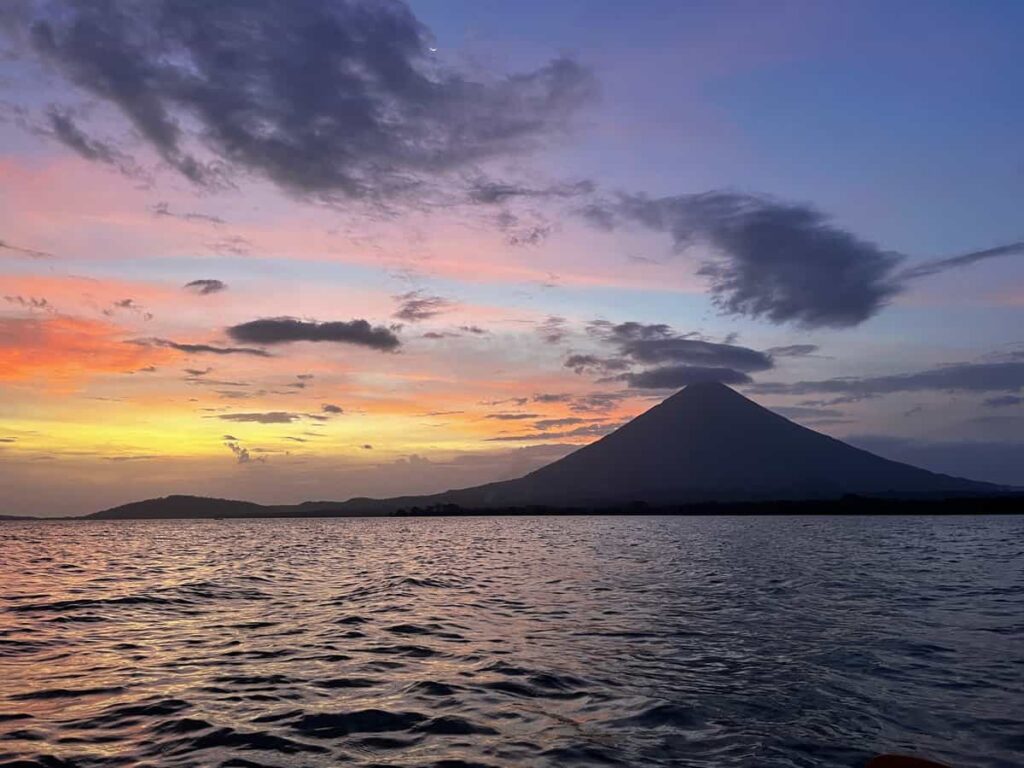
2 Weeks in Nicaragua: My Slow Travel Route
I spent about a month slow-traveling through Nicaragua — working here and there, seeing what happened when I didn’t rush. This itinerary trims that month into a two-week route that still gives you time to soak in each place instead of just ticking it off.
Whether you’re crossing from Costa Rica or flying into Managua, you can follow this loop in either direction. Nicaragua’s compact enough that buses, shuttles, and ferries connect most major stops without too much chaos — and nothing takes more than half a day to reach.Each stop has at least three days because, honestly, I’m not into 24-hour sprints anymore. I wanted time to settle in — to find the fruit stalls, figure out which street dogs belonged to which shop, and actually be in a place, not just pass through it.
San Juan del Sur
San Juan del Sur didn’t blow me away at first. It was hot, a little dusty, and smaller than I expected — a handful of surf shops, smoothie bars, and just enough backpacker buzz to make me suspicious. But it worked. It’s well-connected, walkable, has reliable grocery stores, and enough infrastructure to settle in without much hassle.
Our Airbnb was 20 minutes (on foot) from town — far enough to escape the party scene, close enough to wander in for errands or dinner. There was a shared pool, a busy padel court next door, and by day three, we realized we’d become the kind of people who watch birds. Bright green parakeets, deep-throated calls from trees I couldn’t name, rustling leaves louder than traffic.
Our days revolved around grocery runs, home-cooked meals, and sunset walks. It’s not a destination full of must-sees — it’s the kind of place where you exhale and recalibrate. Nothing flashy, but easy to settle into.
Which Beaches Are Worth It?
If you’re coming to San Juan, you’re probably here for the beaches. There are a lot, but not all are created equal — and some are better if you’re looking for solitude, not surf schools.
- Playa San Juan (in town): Walkable, but crowded and not very clean. Good for convenience, not serenity. Plenty of restaurants and bars.
- Playa Maderas: The classic. Surf-ready waves, hostels, bars, beach parties. Fun, but not peaceful.
- Playa Remanso: Smaller and more chill than Maderas. Still has surf schools, but doesn’t feel overrun.
- Playa Hermosa: Wide, beautiful, less crowded. Privately owned, so there’s a ~$3 entry fee — but worth it for the space and clean water.
- Playa Marsella: Quiet, swimmable, and not far from town. No surf scene, so fewer crowds.
- Playa Las Lajas & Playa Majagual: Harder to reach, but often empty. Bring snacks and water.
And then there’s Playa Lorenzo — our favorite. You either hike 40+ minutes or get creative with transport, but it feels like your own private stretch of coast. White sand, natural shade, and fewer people.
We even found another unnamed beach next door that was somehow better. Just walk over at sunset — the light does all the work.
What to Skip in San Juan del Sur
Unless you’re in the market for dehydration, hookup culture, and cocktails in plastic cups, skip Sunday Funday. It’s Nicaragua’s most famous party — a roving bar crawl full of shouty tank tops. Some people love it. I aged out of it.
Also, the tourist restaurants in town were underwhelming: overpriced and forgettable. You’ll do better cooking for yourself or hitting up local comedores. There’s a Pali and a La Colonia for groceries, plus fruit stalls everywhere for the good stuff.
Where To Stay (and work) in San Juan del Sur
Apartments outnumber hotels here, and that suited us just fine. We found a budget Airbnb with a kitchen and a patio where we could work in the mornings and unwind in the evenings.
San Juan has decent Wi-Fi — good enough for writing, calls, and remote work. If you’re staying long-term or want a quieter base, check out rentals near Playa Remanso or Marsella. More space, fewer parties, better sunsets.
Just keep transport in mind. Moto-taxis and tuk-tuks are around but add up quickly if you’re going in and out of town daily. Many travelers rent motorbikes to get around more freely.
A few cafés in town had coworking-lite vibes (check out Ding Repair Café and Simon Says), but truthfully, San Juan is more hammock than hustle.
Getting In and Out
We crossed overland from San José, Costa Rica, and took a Tica Bus to Rivas. From there, we grabbed a taxi to San Juan. You can also take a local bus from Rivas — it’s cheap (under $2), runs often, and takes about 45 minutes.If you’re heading to Ometepe next, you’ll need to backtrack to Rivas, then on to San Jorge Port to catch the ferry. Easy enough — just expect a little chaos at the port and go early if you’re on a schedule.

Ometepe Island
Getting to Ometepe starts with a ferry from San Jorge. I’d read horror stories about rickety boats and rogue waves, but honestly? It was fine. Not luxurious, but totally routine — they run these ferries daily, and you’ll survive just fine. An hour later, we docked in Moyogalpa, and just like that, we were on an island made entirely of volcanoes.
Ometepe is wild — not in a party way, but in a “how is this place real?” kind of way. Twin volcanoes dominate the skyline. Bananas grow in every direction. Dogs nap in the middle of the road like it’s their living room. Everything is green and slow and quietly surreal.
We stayed near Balgüe, in a spot beside a banana plantation with a wraparound terrace that faced both Concepción and Maderas. Watching the volcanoes shift through the day — clouds pouring over them like smoke, golden light catching their edges at sunset — was easily one of the most beautiful things I saw in Nicaragua.
No, I Didn’t Hike a Volcano — Here’s Why
I know, I know. Everyone comes to Ometepe to hike a volcano. But after trekking in Patagonia just weeks before, the idea of climbing 1,600 meters in Central American humidity felt less like adventure, more like punishment. I opted out — and I don’t regret it.
If you do want to hike, Maderas is the more manageable one: shady, forested, and slower paced. Concepción is brutal — steep, sun-exposed, and straight up.
My Recommendations for Ometepe
Rent a motorbike, scooter, or ATV. It’s the best way to explore the island without relying on unpredictable buses or overpriced taxis. You can loop the island in a day if you want, but the real joy is in stopping. One minute you’re weaving through jungle roads, the next you’re cruising past the lake with volcanoes in your rearview.
We stopped wherever looked interesting: roadside tiendas, lakefront hammocks, tiny soda stands. For swimming, Playa Santo Domingo is a wide, breezy stretch with calm waves and few crowds. You can also kayak on Lake Nicaragua — guesthouses often have rentals or can point you to someone who does. It’s especially peaceful at sunrise or sunset.
Ojo de Agua, the island’s most famous swimming hole, is worth a visit if you go early. Crystal-clear, spring-fed, and incredibly refreshing — but by midday, it gets packed. Go first thing in the morning or skip it for a quiet beach and a cold drink.
If you want more ideas beyond the typical volcano routes – I’ve written a detailed guide to exploring Ometepe based on exactly that kind of slow, unscheduled travel.
Getting There & Around
From Rivas, take a bus or taxi to San Jorge port, where you can buy a same-day ferry ticket to Moyogalpa. The ride takes about an hour.
Once you’re on the island, your best option is to rent a scooter or motorbike — it’s affordable and gives you total freedom (just check your brakes first).
Taxis are available, but pricey and always up for negotiation.
Chicken buses exist too — they move when they feel like it and stop wherever they want. If you’re not in a rush, they’re an entertaining way to see the island.
Where To Stay In Ometepe
We chose Balgüe for its peace, nature, and volcano views. It’s more remote than Moyogalpa, but that means fewer crowds and better scenery. Just bring cash — most places don’t take cards, and the nearest ATM is back in Moyogalpa (which may or may not be working).
If you want convenience, Moyogalpa is easier. You’ll be close to the port, restaurants, and tour operators — and more likely to find working Wi-Fi. But don’t expect charm; it’s functional, not cute.
Ometepe isn’t polished. The roads are rough. Wi-Fi is spotty. Power cuts are common. But it’s one of the few places that genuinely slowed me down — not because I unplugged on purpose, but because the island didn’t care about my schedule. And that was the best part.
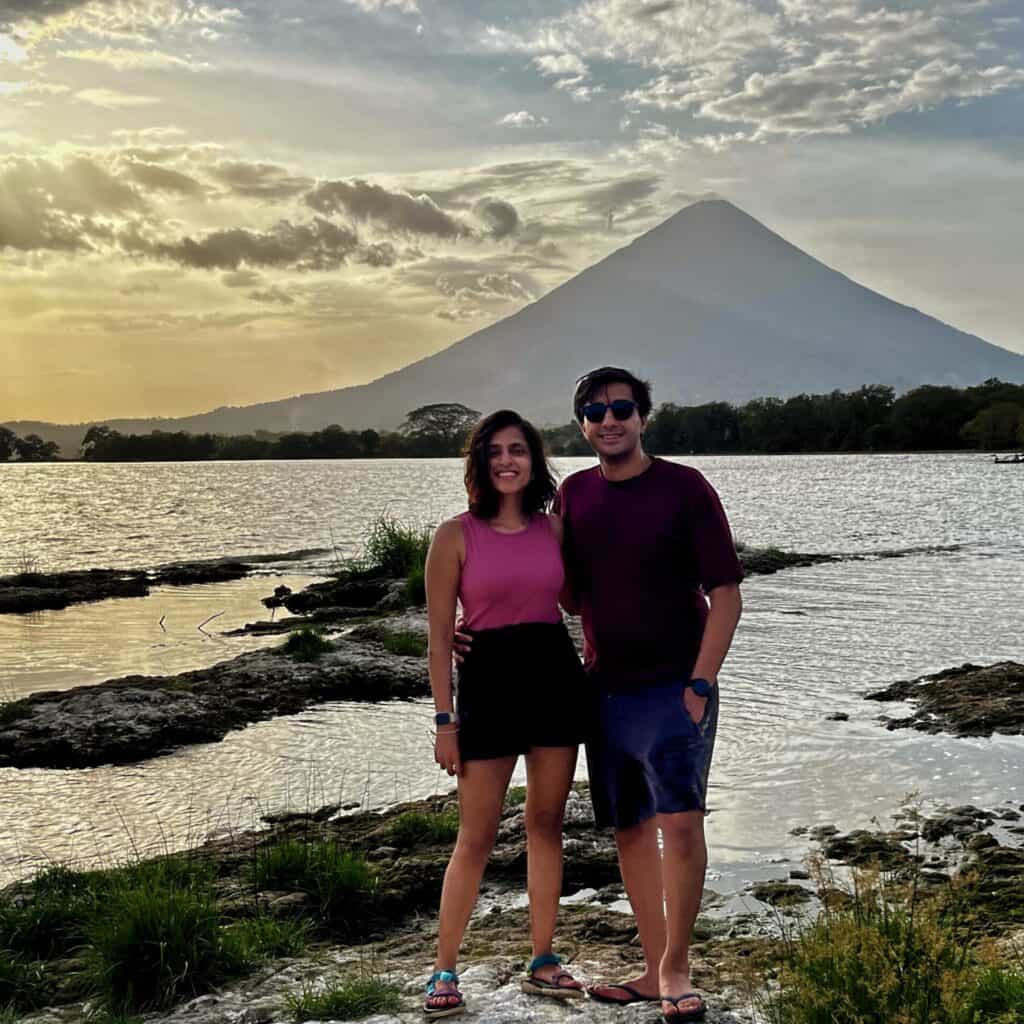
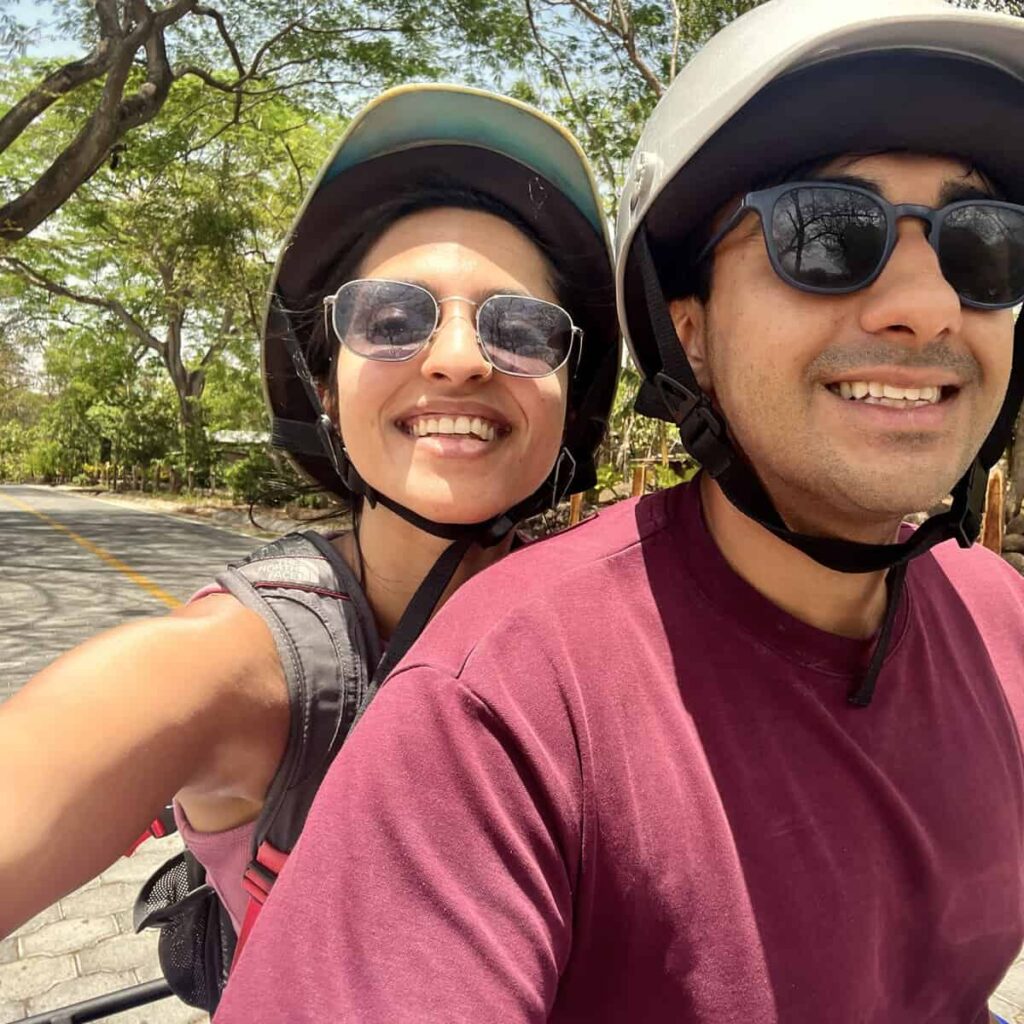
León
We didn’t go to León — not because I didn’t want to, but because we made a deal: no rushing, no city-hopping, two weeks minimum wherever we landed. It was the right choice. It was a good decision, but if I were planning this itinerary for Nicaragua again, León would absolutely be in it.
This is the kind of city that grabs people. Nicaragua’s former capital is still its cultural and political heart, known for revolutionary history, gritty energy, and some of the best street art in the country. It’s also one of the few places on earth where you can throw yourself down a volcano on a plank of wood. Really.
Why You Should Go
- Volcano Boarding at Cerro Negro
Yes, it’s a bit gimmicky. But also? You hike up a black-sand cone and sled down it in an orange jumpsuit. People love it — and when else are you going to say you did that? - Revolutionary History
The Museum of the Revolution is run by former Sandinista fighters and offers a raw, firsthand look at Nicaragua’s recent past. No QR codes, no glossy plaques — just stories, scars, and grit. - León Cathedral
A blinding-white UNESCO site where you can climb to the rooftop for panoramic views of the city and surrounding volcanoes. - Street Life
Markets, murals, and a chaotic, lived-in vibe. Compared to Granada, León feels less polished and more alive. The nightlife skews local — think street beers, dance spots, and late-night eats.
Where To Stay In Leon
León isn’t huge, but it’s dense — most travelers stay within walking distance of the historic center, where you’ll find cafés, markets, street food, and student energy. If you’re planning to work remotely, look for places near the cathedral or central park; that’s where the Wi-Fi tends to be more reliable, and where most coworking-friendly cafés are based.
For a quieter stay, head a few blocks out from the center toward the Guadalupe or Fundeci neighborhoods — still accessible, but less noisy at night.
Granada
The colonial architecture hits you the moment you arrive — bold, crumbling facades in every pastel shade, intricate ironwork, cobblestone streets that make flip-flops a questionable choice. It’s picturesque, but not in a sterile way. It still feels lived-in. Local kids dart down alleyways. Grandmothers sweep doorways. It smells like wood smoke and ripe fruit.
We stayed here for two weeks, but most travelers can get a solid feel for the city in three or four days. I originally came for Masaya Volcano — where you can stand on the rim and look straight into a lava-filled crater — but when we arrived, it was closed due to activity. Typical. Even so, Granada held its own.
Things to Do in Granada
- Wander the old town on foot
It’s flat, easy to navigate, and full of small surprises: hidden courtyards, tiled churches, mango vendors on bikes. - Iglesia de la Merced
Climb to the top for one of the best rooftop views in the city. The stairs are steep and the bell might make you jump, but the panorama is worth it. - Las Isletas boat tour
A calm ride through the tiny lake islands just offshore. Some have monkeys, others have quirky vacation homes. Go early or at golden hour for the best light. - Local markets
The main market is loud, chaotic, and fascinating. You’ll find raw chicken, pirated DVDs, and everything in between. Bring small bills and wear shoes you don’t love.
Where To Stay In Granada
We stayed at Museito De Carlos, and I can’t recommend it enough. Run by the kindest couple, it felt more like staying in someone’s home than in a hotel. The front doubles as a mini museum, the courtyard is leafy and quiet, and the rooms come with actual air conditioning — a rare and welcome luxury.
The best part? Home-cooked breakfast every morning: fruit, eggs, gallo pinto, coffee. Some days we sat at the table way too long just talking with the hosts.
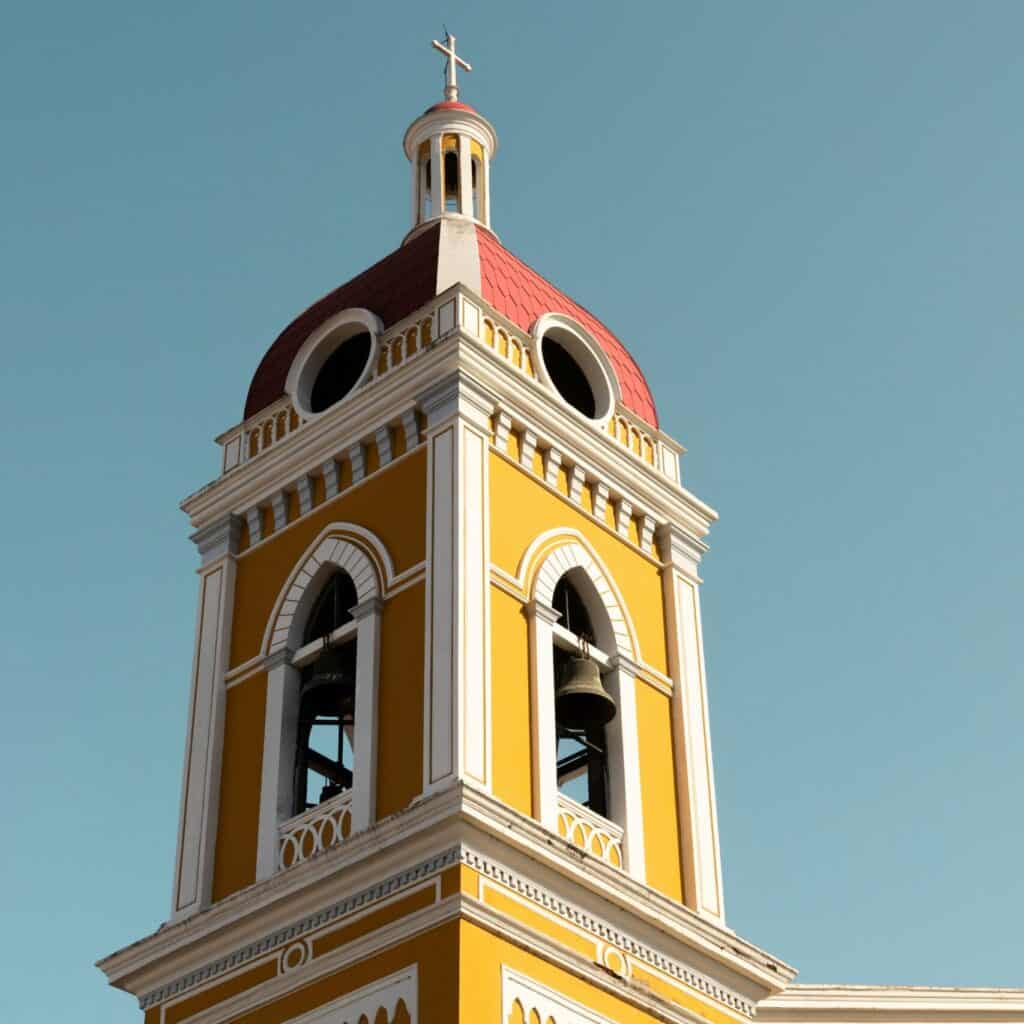
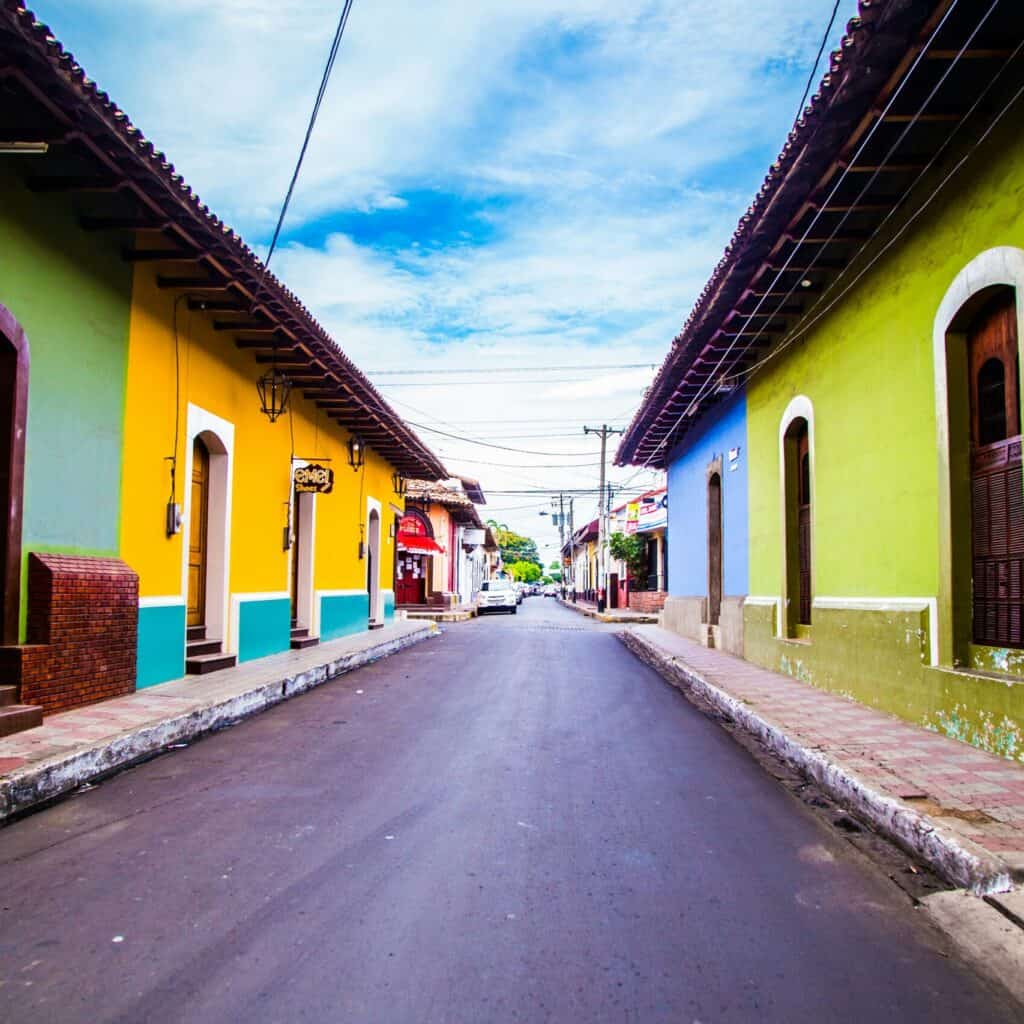
Other Places to Consider (If You Have More Time or Niche Interests)
If you’ve got extra days or like your travel a little weirder or wilder, here are a few more stops to think about:
- Matagalpa
Up in the highlands, known for cool weather, coffee farms, and hiking trails. A great break if you’re melting on the Pacific side. Slower pace, fewer tourists than León or Granada. - Popoyo
A laid-back surf town with a calmer vibe than San Juan del Sur. Fewer crowds, more yoga, and long, empty beaches. Good for remote work or if you want waves without the party scene. - Little Corn Island
Harder to reach — you’ll need to fly or endure a long bus-ferry combo — but worth it if you’re craving Caribbean stillness. No cars, clear water, great snorkeling. Bring cash, a book, and strong bug spray.
Places I’d Skip (Unless You Have Time to Burn)
- Bluefields / Caribbean Coast
Long travel days, tricky infrastructure, and not much to do unless you have local connections. - Managua
Transit hub, not a destination. You’ll likely pass through — just don’t plan to hang around.
Travel Logistics & Tips for Nicaragua
Here are a few practical travel tips for Nicaragua to keep your trip smooth, sweaty, and scam-free.
Money & Budgeting
- The local currency is the Nicaraguan córdoba, but U.S. dollars are accepted in most tourist areas.
- Cash is king — especially on islands and in small towns.
- Budget travelers can get by on $20–30/day if you cook, take buses, and skip tours. Hostels start around $10–15, local meals are $3–5, buses $1–3.
Internet & SIM Cards
- Wi-Fi is decent in cities, patchy in places like Ometepe and Little Corn. Don’t count on streaming speeds.
- I always use an Airalo eSIM for mobile data — super convenient, cheap, and no need to fumble with a local SIM card.
Visa & Entry
- Most travelers from the U.S., Canada, and EU get a 90-day visa on arrival, valid for Nicaragua and the rest of the CA-4 region (Guatemala, Honduras, El Salvador).
- I entered on a Pakistani passport with a U.S. B2 visa — which got me a 30-day stay. At the Costa Rica–Nicaragua land border, I paid $50 USD for an on-the-spot stamp. My Canadian partner paid less.
- If you’re crossing overland (especially from Costa Rica), I’ve written a full guide with tips on what to bring, how much to pay, and what to expect.
- If you’re also Pakistani (or have a weaker Passport): I have a blog post on the list of countries you can visit with an US B2 visa/Canadian visa or valid Schenghen visa.
Other Tips
- Air conditioning is rare. Filter for it when booking, especially in León and Granada.
- Most guesthouses provide filtered water. Don’t drink from the tap unless you’re itching for a gut cleanse.
- Spanish helps. English is spoken in tourist zones, but don’t count on it in rural areas.
That’s The Trip
Nicaragua surprised me. Not just because it was cheap (though it was), or underhyped (also true), but because it felt like a place you could be — not just bounce through.
It’s not always easy. The roads are rough. The power goes out. Wi-Fi flakes. You’ll sweat through clothes faster than you can wash them. But if you like slow travel, rough edges, and finding magic in the in-between moments — Nicaragua might be your place too.
Say yes to the weird ferry. The dusty chicken bus. The sunset swim. The beach with no name. You don’t need a packed itinerary to enjoy Nicaragua. You just need time, curiosity, and maybe a bit of sunscreen. ❤︎
Related Posts
- El Calafate vs. El Chaltén: Which Patagonia Town Should You Choose?
- Costa Rica to Nicaragua Border Crossing: All You Need To Know
- Nicaragua Itinerary: How I Spent a Month Between Beaches, Volcanoes, and ‘Is It Safe?’
- 15+ Incredible Things To Do In Ometepe
- Itinerary for Argentina: Patagonia, Mendoza, and a Bit of Malbec
- How to Hike to Confluencia Base Camp (Without Climbing Aconcagua)
